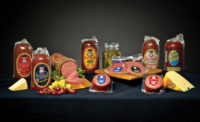Most people who buy Burgers’ Smokehouse products never make the trip out to California, Mo. It is easier, after all, to buy its renowned country hams, bacon or fully cooked ribs online from the comfort of their home, or from their local grocery store. Those who do make the trek out to the company’s Central Missouri headquarters will see more than a fully stocked country store. They find a tourist destination with a visitor’s center that, with the help of an animatronic farmhand, educates them about how country hams are made. Visitors can also learn about the company’s 65-year history, see some of its artifacts and awards, and get to know the past and present generations of family owners.
Burgers’ has every right to be proud of its heritage. Since the company was founded by E.M. Burger in 1952, the company has become one of the leading country ham makers in the U.S. Its mail-order business sends out about 3 million catalogs every year, and its hams and smoked turkeys are holiday staples of tens of thousands of holiday dinners annually. Burgers’ Smokehouse has undergone many expansions, additions and upgrades, but the important aspects of its business haven’t changed. The company still uses its traditional curing methods; it’s just applying its traditions to a wider range of products, and at a larger scale than ever before.
For example, country hams — still the leading product — are dry-cured and hand-rubbed with the cure mixture before being placed into a bag and tied up to age. That method has not changed much since the company’s early days. Once the hams come out of the smokehouse, though, the company utilizes a combination of worker expertise and technological innovations to get the hams out to its mail-order, retail, private label and foodservice customers.
“We try to keep up with technology where it fits with us, but we’re going to research it heavily and believe it’s the right technology for our business at the time,” explains Keith Fletcher, senior vice president of operations.
That research takes time, and Burgers’ is cautious when it comes to its capital investments. The company added a water knife 15 years ago to aid its portion-cutting operations, but that decision came after 12 years of seeing the equipment at trade shows, researching the technology and talking with the suppliers before finally pulling the trigger. A more recent acquisition, an HPP (high-pressure processing) machine, came after watching the technology develop for eight years.
“It came to a point where we finally said as a group that it was time to do so, as far as a food safety opportunity for us, our customers and our business,” Fletcher says.
The HPP machine is used on all of the items Burgers’ manufactures that are fully cooked, offering a 5-log pathogen reduction. Along with the food safety benefits, Fletcher also notes that the HPP technology allows the company to remove some of the inhibitors that it had to use previously to provide shelf life and food safety assurances.
“You had to do a lot of fooling around with your formulas to make those inhibitors work, because they’re sodium-based,” he explains. “Now, this technology allows us to pull some of that out of it, which lets us go back to some of your earlier, better formulations that we had.”
The combination of the technology and the company’s quality standards means that future products will have the shelf life and food safety demands that its retail and private label customers need, along with the taste and simple ingredients that the end user wants. As the clean-label movement grows, Burgers’ will be ready.
“As all those consumer movements continue to develop, we’ll have the technology that will allow us to safely proceed with some of those innovations. It’s going to be tremendous for product development,” says Steven Burger, president of the company.
Steven, grandson of founder E.M. Burger and son of Morris Burger, formally entered the family business in 1984, though he was involved in the business much earlier than that. He and his brother Philip, corporate vice president, are part of the third generation, along with Fletcher and others who have married into the family. Some members of the fourth generation have joined the team as well, having fulfilled the requirements of working outside the family business for a minimum of two years. (The family Council has formal requirements and a custom growth plan for all family members who come onboard.)
Philip Burger entered the business two years after Steven did and was tasked with modernizing the company’s mail-order business. Burgers’ had been mailing catalogs since the 1960s, but those sales had plateaued by the mid-‘80s. He helped modernize the operations and shepherded the company into the Internet in the early days of the web — its early online presence helped the company secure the valuable www.smokehouse.com URL.
Today, Philip says that the company’s business is roughly divided equally between three segments — foodservice, mail-order and wholesale/retail/private label. Burgers’ mails catalogs about 12 times a year. He says that even in the age of the Internet, that paper catalog inspires more orders than anything else.
“We mail a catalog, and you can exactly see the spikes that go with online ordering. Not to say that there aren’t some other advertising avenues online, but the catalog is still the big driver of business,” he says.
The bulk of the orders come toward the end of the year, when consumers are looking for the main dishes for their holiday dinners or to send a holiday gift. Because of that demand, Burgers’ has had to design its plant to be highly flexible. Some rooms that are used as coolers or production areas in one part of the year can shift to freezers when it’s time to stock up on products for the holiday rush.
The mail-order department will be one of the beneficiaries of an upcoming 40,000-square-foot expansion. Along with additional smokehouses, the three-story addition will dedicate two floors to dry storage and the mail-order department.
“You could kind of compare it to a mall,” Philip says of the mail-order business’ space requirements. “[Malls] have these huge parking lots that probably sit half-empty 10 months of the year, and then November and December they might fill up. So we have to have a big area to handle a small volume.”
Along with its most popular products, Burgers’ Smokehouse is constantly working on new products. While its best-sellers are its traditional hams, bacon and poultry products, fully cooked ribs are growing in popularity. The company is working on a retail program to help grocery stores promote different, seasonal sauced ribs throughout the year. One recent introduction that proved very popular among consumers was a Honey Buffalo rib.
“We have a pretty unique method of cooking. It takes quite a bit of patience to take a fresh rib and turn out a cooked rib like we want it and have the proper look, proper mouthfeel,” Philip says. “It fits what we do here, which is to focus in on the products that require a little more attention to detail. The big guys just probably don’t have the patience to do some of the things that we do.”
Burgers’ Smokehouse is in the unique position of looking back while moving forward. The technology investments give the company a cutting-edge production floor, and new additions — a second water knife was recently installed, and the expansion will begin later this year — will help the company grow its capabilities and customer reach even further. At the same time, Burgers’ has more than 50 years of experience and a cadre of loyal customers. Telling consumers about that heritage is a key facet of a planned brand refresh.
Steven Burger notes that the brand’s last refresh took place about seven years ago.
“We decided it was time for a new look,” he says.
Burgers’ brought in a new director of marketing, Kelly Perrier, and tasked her with leading the project. Along with a modified logo, Perrier says that the most significant changes will be in relating the company’s story on its packaging.
“We’re really focused on communicating some of the things that we’re doing, such as our dry-rubbed curing methods, our aging methods and the hands-on inspection and care that we take in making all of our products,” she says. “We have taken all these extra steps to ensure that we are a quality and flavorful eating experience — something to put on your table but also to share with your family and friends.”
Perrier notes that, due to the company’s production methods and quality standards, Burgers’ bacon and other retail items will never fit into the low-cost price point. While every shopper is a potential target, Burgers’ consumers must be willing to pay for a premium eating experience.
“As we have tried to target who we are and who our products are most applicable to, it has to be someone who appreciates real food and craves that real eating experience. They are truly living to eat and not eating to live,” she says.
One of the goals of the project will be to bring attention to the depth and breadth of products that Burgers’ offers — especially for customers who know of it as a bacon company or a ham company.
“People are continually pleasantly surprised as they learn about some of the things we’re able to do here and accomplish at Burgers’ Smokehouse,” Perrier says.
Philip Burger is quick to point out that most of the company’s success lies in its reputation, which is in turn due to the employees’ dedication to their work.
“Most of our success has come from that group of people,” he says. “Quality can be challenged at any time, but for the most part, it’s seeing that it gets done correctly and consistently.
“I can sit here and be this trumpet that plays before you, but the orchestra is back there. They’re doing the work,” he adds.






















